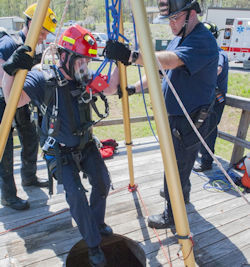Rescue Equipment
The importance of having the right rescue equipment on hand can't be stressed enough.
Rescue equipment may include:
- full body harness with retrieval line attached
- wristlets (may be used in rescue when it can be shown that they are the safest and most effective means of rescue)
- hand-cranked mechanical winch and tripod (required when entrant is five feet or more below the entrance)
- ladder
- explosion-proof lighting
- SCBA/SAR
- stretcher
- approved head protection
Full Body Harness and Retrieval Lines
All authorized entrants and rescuers entering permit-required spaces are required to use full body harnesses and retrieval lines, unless it is determined that the retrieval equipment would increase the overall risk of entry or would not contribute to the rescue operation.
What kind of equipment should be used for lowering or lifting entrants?
Only devices designed by the manufacturer and approved for moving humans should be used. The equipment must enable a rescuer to remove the injured employee from the space quickly without injuring the rescuer or further harming the victim.
If there is even a remote possibility of other atmospheric contaminants, even though monitoring equipment readings appear to be within the normal ranges, rescuers should still use appropriate respiratory protection. Play it safe:
- Wear SCBA or SAR.
- Do not use air purifying respirators for confined space rescue.
Knowledge Check Choose the best answer for the question.
8-8. All entrants and rescuers entering permit-required confined spaces are required to use _____.
You forgot to answer the question!

